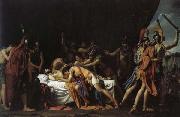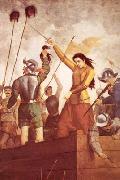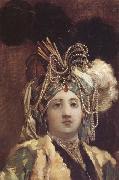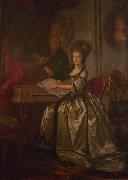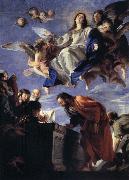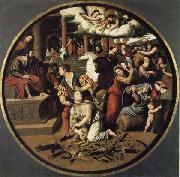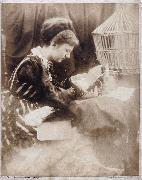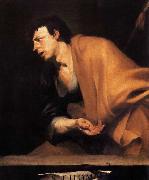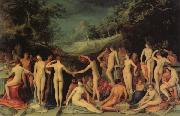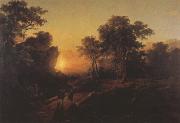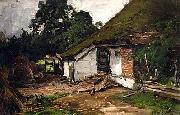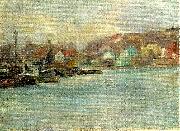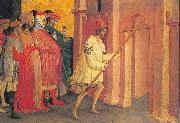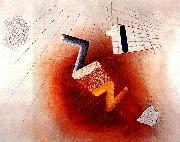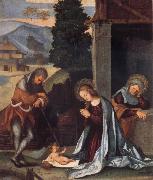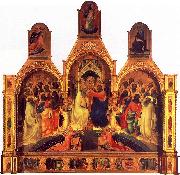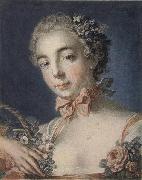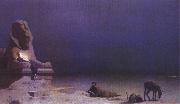|
|
|
|
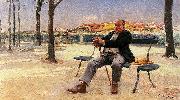 |
Jose Malhoa
|
|
(Caldas da Rainha, 28 April 1855 ; Figueire dos Vinhos, 26 October 1933) was a Portuguese painter.
Malhoa was, with Columbano Bordalo Pinheiro, the leading name in Portuguese naturalist painting, in the second half of the 19th century. He painted often popular scenes and subjects, like his two most famous paintings, "The Drunks" (1907) and "Fado" (1910). He always remained faithful to the naturalist style, but in some of is works, there are impressionist influences, like in his "Autumn" (1918), that can be considered as an "impressionist exercise".
He saw at the end of his life, the inauguration of the Jose Malhoa Museum, in Caldas da Rainha.
|
|
|
|
|
|
|
|
|
|
|
|
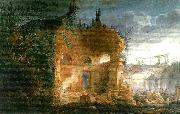 |
joseph michael gandy
|
|
Joseph Michael Gandy (1771 - 1843) was an English artist, visionary architect and architectural theorist, most noted for his imaginative paintings depicting Sir John Soane's architectural designs. He worked extensively with Soane both as draughtsman and creative partner from 1798 until 1809 when he (ultimately unsuccessfully) set up his own practice.
Gandy built little in his career, having a reputation as a difficult individual to deal with. However his work included the Phoenix Fire and Pelican Life Insurance Offices (1804?C1805, destroyed ca. 1920) in London, Doric House at Sion Hill in Bath (1818), and the remodelling of Swerford Park house in Oxfordshire (1824?C1829). Commercially he was a failure and served two terms in a debtors' prison, but his published and exhibited work was largely a critical and popular success. In 1821 he published two articles in the Magazine of Fine Arts on The Philosophy of Architecture. He intended to expand upon this subject in an eight-volume work entitled Art, Philosophy and Science of Architecture, of which his unpublished manuscript survives.
His paintings show a dramatic use of two-point perspective and architectural precision, and also reflect his (and Soane's) fascination with Roman ruins. His architectural fantasies owe a clear debt to Piranesi and play upon historical, literary and mythological themes with a feeling for the sublime that is the equal of his contemporaries J. M. W. Turner and John Martin.
He died in a private asylum in Devon where he had been placed by his family in 1839. Many of his paintings can be seen in the Pictures Room of Sir John Soane's Museum in London. |
|
|
|
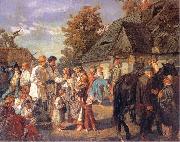 |
jozef marian chelmonski
|
|
Jozef Marian Chełmoski (November 7, 1849 -- April 6, 1914) was a Polish painter.
Chełmoski was born in the village of Boczki near Łowicz in central Congress Poland, Russian Empire. His first drawing teacher was his father (a small leaseholder and administrator of Boczki village). After finishing high school in Warsaw, he studied in Warsaw Drawing Class (1867C1871) and took private lessons from Wojciech Gerson. From 1871 to 1874 Chełmoski lived in Munich. He worked with Polish painters assembled around Jozef Brandt and Maksymilian Gierymski. He also had studied for a few months at the academy of H. Anschutz and A. Strahuber. In 1872 and 1874 Chełmoski visited the Polish territories (Poland as a country did not exist then), Tatra Mountains and Ukraine.
His first paintings were done under the influence of Gerson. The works that followed were landscapes and villages. In 1875 Chełmoski went to Paris, where he had many important exhibitions and became known to the art scene. With many orders, the artistic level of his paintings decreased.
From 1878 to 1887 Chełmoski visited Poland, Vienna and Venice. In 1887 he returned to Poland and in 1889 settled in Kuklewka Zarzeczna village. Contact with his homeland and nature revealed quality in his artworks. From that time are the best liked Chełmoski's paintings such as Partridge on the Snow, The Storks or Before Thunderstorm.
Chełmoski represented the trend in art called "Polish Patriotic Painting".
He died in Kuklewka near Grodzisk Mazowiecki in 1914.
|
|
 |
Jozef Marian Chelmonski
|
|
(November 7, 1849 - April 6, 1914) was a Polish painter.
Chełmoeski was born in the village of Boczki near Łowicz in central Congress Poland, Russian Empire. His first drawing teacher was his father (a small leaseholder and administrator of Boczki village). After finishing high school in Warsaw, Jozef studied in Warsaw Drawing Class (1867-1871) and took private lessons from Wojciech Gerson. From 1871 to 1874 Chełmoeski lived in Munich. He worked with Polish painters assembled around Jozef Brandt and Maksymilian Gierymski. There, he also studied for a few months at the academy of H. Anschutz and A. Strahuber. In 1872 and 1874 Chełmoeski visited the Polish Territories (Poland, as an independent country, did not exist during this time), Tatra Mountains and Ukraine.
His first paintings were done under the influence of Gerson. The works that followed were landscapes and villages. In 1875 Chełmoeski went to Paris, where he had many important exhibitions and became known to the art scene. With many orders, the artistic level of his paintings decreased.
From 1878 to 1887 Chełmoeski visited Poland, Vienna and Venice. In 1887 he returned to Poland and in 1889 settled in the village of Kuklewka Zarzeczna. Contact with his homeland and nature are qualities revealed in his artworks. From that time are the best liked, or the most beloved of Chełmoeski's paintings are paintings such as Partridge on the Snow, The Storks or Before Thunderstorm.
|
|
|
|
 |
Juan Manuel Blanes
|
|
(June 8, 1830 - April 15, 1901) was a noted Uruguayan painter of the Realist school.
Blanes was born in Montevideo, Uruguay, in 1830. He was raised by his mother, with whom he relocated to the countryside in his early teens. Blanes took an interest in drawing at this point, and shortly afterwards, was hired as an illustrator for a Montevideo newsdaily, El Defensor de la Independencia Americana. Earning extra income with watercolors, he returned to his mother and, in 1854, established his first atelier.
He married Marea Linari, and in 1855, the couple settled in Salto, where he worked as a portrait painter. They relocated to Concepcien del Uruguay (across the Uruguay River, in Argentina) in 1857, and Blanes was commissioned by Argentine President Justo Jose de Urquiza to complete a number of portraits, allegories and landscapes to grace his nearby estancia, the Palacio San Jose. Returning to Montevideo in 1861, the talented painter obtained a scholarship from the Uruguayan government, and with it, traveled with his family to Florence, Italy, where he studied under Antonio Ciseri until 1864.
The experience became a valuable calling card for Blanes, who became of Uruguay's most sought-after portraiteurs. The 1871 outbreak of a yellow fever epidemic in Buenos Aires inspired his first renowned work, which he exhibited to acclaim in the recovering city. His 1872 portrait of the Argentine War of Independence hero, General Jose de San Marten (The Review in Rancagua), was also a success in Buenos Aires, and Blanes was invited to Chile to display the historic depiction. |
|
|
|
|
|
|
|
|
|
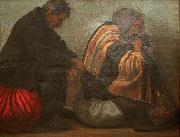 |
Karel Myslbek
|
|
Karel Myslbek (1874-1915)Aliases: Frant. VovesProfessions: Figure painter; Painter. |
|
|
|
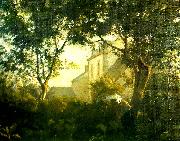 |
karl madsen
|
|
(1855-1938), Danish art historian, director of Statens Museum for Kunst |
|
|
|
|
|
|
|
|
|
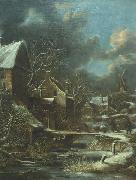 |
Klaes Molenaer
|
|
(1630, Haarlem - 1676, Haarlem), was a Dutch Golden Age painter.
According to the RKD he was the brother of the painters Bartholomeus and Jan Miense Molenaer. He became a member of the Haarlem Guild of St. Luke in 1651 and paid dues yearly until 1676.He was a landscape painter influenced by Jacob van Ruisdael.
|
|
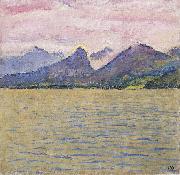 |
Koloman Moser
|
|
Koloman Moser (German pronunciation: [ˈkoːloman ˈmoːzɐ]) (March 30, 1868 - October 18, 1918) was an Austrian artist who exerted considerable influence on twentieth-century graphic art and one of the foremost artists of the Vienna Secession movement and a co-founder of Wiener Werkstätte.
During his life, Moser designed a wide array of art works - books and graphic works from postage stamps to magazine vignettes; fashion; stained glass windows, porcelains and ceramics, blown glass, tableware, silver, jewelry, and furniture - to name a few of his interests.
Born in Vienna, he studied at the Wiener Akademie and the Kunstgewerbeschule, where he also taught from 1899.
His designs in architecture, furniture, jewelry, graphics, and tapestries helped characterize the work of this era. Moser drew upon the clean lines and repetitive motifs of classical Greek and Roman art and architecture in reaction to the Baroque decadence of his turn-of-the-century Viennese surroundings.
In 1901/1902, he published a portfolio titled Die Quelle ("The Source") of elegant graphic designs for such things as tapestries, fabrics, and wallpaper.
In 1903, Moser and his colleague Josef Hoffmann founded Wiener Werkstätte, whose studios and artisans produced a number of aesthetically and functionally designed household goods, including glassware, flatware, silverware, and textiles. In 1904, he created the Apse mosaic and glass windows for the Kirche am Steinhof in Vienna.
Steinhof Church commemorative coin
In 1905, together with the Klimt group, he separated from the Vienna Secession. The same year, he married Editha (Ditha) Mautner von Markhof, the daughter to one of Austria's great industry fortunes.
In 1907 Kolo Moser, due to internal conflicts and as his plans for reorganising the Werkstätte (to cope with financial problems) weren't realised, withdrew from the Wiener Werkstätte.
Koloman was one of the designers for Austria's leading art journal Ver Sacrum. This art journal paid great attention to design and was designed mainly by Moser, Gustav Klimt and Josef Hoffmann.
|
|
|
|
 |
konrad magi
|
|
konrad magi(1878 to 1925),was an Estonian landscape painter. He was one of the most colour-sensitive Estonian painters of the first decades of the 20th century, and Magi works on motives of the island of Saaremaa are the first modern Estonian nature paintings.
Magi received his elementary art education from the drawing courses of the German Artisans Society of Tartu (1899?C1902.) At the same time, he was keenly engaged in theater, violin, and various sports.
Magi continued his art education as an unattached student in Saint Petersburg (1903?C1905.) In the autumn of 1907, he went to Paris. There Magi studied at a free academy. From 1908 to 1910, he lived in Norway. In 1912, Magi returned to Tartu, where he worked as an art teacher.
In Åland, he created delicate plant vignettes in the style of Art Nouveau: Kahekesi (Two together; 1908; China ink drawing). In Paris, Magi was influenced by Impressionism and Fauvism, which had a significant impact on his colours: Lilleline vali majakesega (A flower field with a little house; 1908?C1909), Norra maastik manniga (A Norwegian landscape with a pine; 1910).
From 1918, the influence of Expressionism is manifest, fostered by Mägi extreme sensitivity and emotional response to the anxious times: Puhajarv (Lake Puha, ', ', ', ', ', ', ', '); 1918?C1920), Otepaa maastik (Landscape of Otepaa; 1918?C1920). Also influenced by Expressionism are his big figure compositions Piet?? (1919), Kolgata (Golgatha; 1921).
Konrad Magi - Rannamaastik (Beach landscape)Magi new artistic period, begun on a trip to Italy, brought calmer tempers: Varemed Capril (Ruins in Capri; 1922?C1923). Along with nature pictures, he painted flowers and portraits. Magi mostly beautiful female models express the Art Nouveau ideal of beauty: Holsti (1916). In his later portraits from the 1920s, a more serious temper is expressed: Madonna (1923?C1924).
|
|
 |
Konstantin Makovsky
|
|
1839 September 17 [O.S. September 30] 1915) was an influential Russian painter, affiliated with the "Peredvizhniki (Wanderers)". Many of his historical paintings, such as The Russian Bride's Attire (1889), showed an idealized view of Russian life of prior centuries. He is often considered a representative of a Salon art.
Konstantin was born in Moscow as the older son of a Russian art figure and amateur painter, Yegor Ivanovich Makovsky. Yegor Makovsky was the founder of Natural class, the art school that later became as the famous Moscow School of Painting, Sculpture and Architecture. Among the friends of the family were Karl Briullov and Vasily Tropinin. All children of Yegor became notable painters (see Makovsky). Later Konstantin wrote For what I became I think I should thank not the Academy or Professors but only my father.
In 1851 Konstantin entered the Moscow School of Painting, Sculpture and Architecture where he became the top student, easily getting all the available awards. |
|
|
|
|
|
|
|
|
|
|
|
|
|
|
|
|
|
|
|
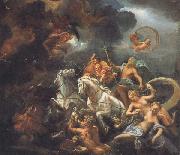 |
Livio Mehus
|
|
The Flemish artist (1627-1691) eclectic painter, author of landscapes, sacred objects, genre paintings and portraits embodies |
|
|
|
|
|
|
|
 |
Louis Michel Eilshemius
|
|
(February 4, 1864 - December 29, 1941) was an American painter, primarily of landscapes and nudes. Although he was academically trained, much of his work has the unself-aware character of naive art. Eilshemius was a grandson of Swiss painter Louis-Leopold Robert.
Born near Newark, New Jersey into a wealthy family, his earliest education was in Europe, after which he spent two years at Cornell University before his art studies began at the Art Students League of New York. He subsequently studied under Bouguereau at the Academie Julian in Paris, and traveled widely in Europe, Africa and the South Seas, returning to the family brownstone in New York City where he was to live for the rest of his life. |
|
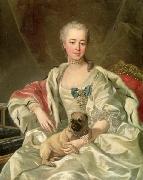 |
Louis Michel van Loo
|
|
Louis-Michel van Loo (2 March 1707-20 March 1771) was a French painter.
He studied under his father, the painter Jean-Baptiste van Loo, at Turin and Rome, and he won a prize at the Academie Royale de Peinture et de Sculpture in Paris in 1725. With his uncle, the painter Charles-Andre van Loo, he went to Rome in 1727 - 1732, and in 1736 he became court painter to Philip V of Spain at Madrid, where he was a founder-member of the Academy in 1752. He returned to Paris in 1753, and painted many portraits of Louis XV of France. In 1765 he succeeded Charles-Andre as director of the special school of the French academy known as the Ecole Royale des Eleves Proteges. In 1766 he made the portrait of the Portuguese statesman Sebastiao de Melo, Marquis of Pombal.
Among his brothers were the painters Francois van Loo (1708 - 1732) and Charles-Amedee-Philippe van Loo (1719 - 1795). |
|
 |
Louis Moritz
|
|
painted Portrait of Jonas Daniël Meijer (1780-1834), jurist. in 1800-1834
|
|
|
|
|
|
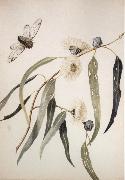 |
Louisa Anne Meredith
|
|
English miniaturist, watercolourist, engraver, poet, writer and botanist .
1812-1895
|
|
 |
Louise Moillon
|
|
(1610-1696) was a French painter in the Baroque era. She became known as one of the best female still life painters during her time, and worked for King Charles I of England, as well as the French nobility.
Moillon came from a strict Calvinist family. Her father, brother Isaac, and stepfather were both paint dealers and artists themselves. According to the RKD, Louise (also known as Louisa) learned to paint from her father Nicolas Moillon and Francois Garnier. She gained her particular style of still life painting from the Academie de Saint-Germain-des-Pres. She usually signed her paintings with Louyse Moillon. Moillon lived and worked in France her whole life. |
|
|
|
|







